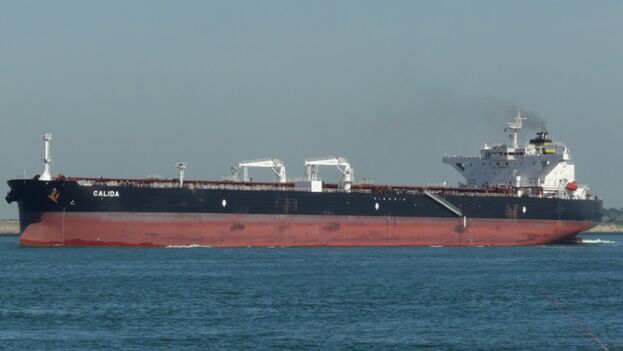
![]() 14ymedio, Havana, 11 May 2023 — As happened with the Orange Spirit, which brought American chicken last week, and with several tankers in recent months, the official Cuban press again omitted the name and origin of an oil tanker that docked at the port of Matanzas this Wednesday to unload 40,000 tons of diesel. Nor did it give information about the origin of the fuel, for which it paid 29 million dollars.
14ymedio, Havana, 11 May 2023 — As happened with the Orange Spirit, which brought American chicken last week, and with several tankers in recent months, the official Cuban press again omitted the name and origin of an oil tanker that docked at the port of Matanzas this Wednesday to unload 40,000 tons of diesel. Nor did it give information about the origin of the fuel, for which it paid 29 million dollars.
The record suggests that the cargo comes from Russia and was “laundered” in Turkey to circumvent the embargo by the NATO countries, in response to the invasion of Ukraine by Moscow’s troops. This measure does not apply to Cuba but to certain countries such as the United States, where the ship stopped before reaching Matanzas.
Of this, not a word in the report of Cuban Television, which goes to the extreme of disseminating a report with images of another oil tanker, the Cheetah-II, that entered that same port on April 27 from the Russian port of Tuapsé in the Black Sea and made a stopover in Istanbul but did not pass through the United States. However, according to ship geolocation pages consulted by 14ymedio, the Cheetah-II has been in Santiago de Cuba since May 2.
On the other hand, the official journalist Bernardo Espinosa, author of the report, illustrated the arrival of the tanker at the port of Matanzas this Thursday with the photographs of the Cheetah-II used in a previous work on April 27.
According to satellite monitoring by Vesselfinder and Marine Traffic, the only oil tanker that docked this Wednesday at the Matanzas Deepwater Pier was the Calida, a ship that sails with the flag of Malta, coming from Istanbul, Turkey, after having made a stopover in the Netherlands and on April 30 at the port of Corpus Christi, in Texas, United States.
The Cuban authorities have not made any mention of Calida, an oil tanker with 817 feet of length and 144 feat of width. In addition to two small tugboats with the Cuban flag, the only ship that is currently in the Matancera terminal, since April 30, is the Marianna V.V., an oil tanker with the Liberian flag.
According to Televisión Cubana, the ship docked at the Matanzas Deepwater Pier and, after “certifying the quality of the product,” the unloading to another ship began, an operation that is expected to be completed in 48 hours. “This allows us to quickly reach other ports that are also in need of fuel,” said Lidia Rodríguez, director of the Commercial Company of the Cuban Oil Union (Cupet).
“The cargo of this ship will not mean increases in the volumes to be marketed,” warned the officials interviewed by national television, who described the cargo as “insufficient,” although it helped to “not reach zero” in terms of electricity generation. Twenty thousand tons of unloaded diesel will be dedicated, according to officials, to electricity generation, and the same amount to “basic services.”
“We know the conditions that there are with the fuel,” said Ower Luis Grau, head of Áreas at the Mantanzas pier, who added that “most of the fuel that enters this country” is discharged through that terminal and is expected to “arrive quickly” to the other provinces.
Cuban Television added that the Island is eager to “receive new imports,” some already “in business phases” and others en route to Cuba. Before the end of May, the officials assured, other shipments of fuel will arrive.
On April 27, when the Cheetah-II arrived in Matanzas, the authorities were also secretive with the information about the ship. At that time, the official press guaranteed that diesel would also be used in electricity generation and in “sectors of the economy and the social area.”
The shipment also did not mean an improvement in the sale of hydrocarbons to private drivers on the Island. The Minister of Energy and Mines, Vicente de la O Levy, insisted on the idea of “not touching zero with fuels,” but the situation remains in the most complete precariousness.
What the Cuban government does not report is where the fuel comes from and through which negotiations it enters Cuba. The Reuters agency recently revealed that Mexico increased its crude oil exports to the Island, and that has not meant a relief for the fuel crisis in the country either.
Translated by Regina Anavy
____________
COLLABORATE WITH OUR WORK: The 14ymedio team is committed to practicing serious journalism that reflects Cuba’s reality in all its depth. Thank you for joining us on this long journey. We invite you to continue supporting us by becoming a member of 14ymedio now. Together we can continue transforming journalism in Cuba.
